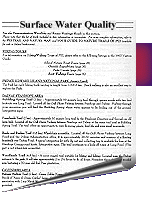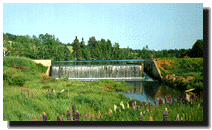

Approximately 27 percent of the Island’s annual
rainfall eventually makes its way to the numerous
streams, rivers, estuaries, lakes, ponds, bogs, and
swamps throughout the province. These watercourses and
wetlands are a vital yet overlooked part of our Island
landscape. They are living systems, providing immensely
complex habitat for a great diversity of wildlife beneath
the surface of the water and along the water’s edge.
All of the Island’s wildlife population relies on a
close relationship with surface water bodies. The salty
barrier beach-ponds along the coastline are home to ducks
(blue-winged teal, blacks, pintails), geese, and many
edible wild plants. Rivers and streams are inhabited by
beaver, muskrat, and otter, with clams inhabiting the
river mouths. Thousands of insects and invertebrates
(daphnia, hydra, caddis fly) and their larvae inhabit the
summer pond. They provide food for trout which digest
insects using sand and gravel in their stomach to help
grind up insect shells.
The great blue heron stands in the shallows hunting for
sticklebacks and frogs. Red-winged blackbirds, horned
owl, and nighthawk soar overhead, scouting their terrain.
Pond plants (cattails, bullrushes, wild rice, and
duckweed) absorb nutrients from the water. In the
presence of sunlight, they release oxygen and produce
sugars and starches, which then benefit other living
creatures. In winter, foxes and mink wait for muskrat to
raise their head from holes in the ice.
With the exception of coastal
barrier ponds and the rare boggy pond, virtually all
Island ponds and lakes are man-made. They provide water
for agriculture as well as a place to boat, fish, hunt,
trap, or skate. However abundant, these ponds need human
intervention to remain fertile. Dams must be properly
cared for, fish ladders maintained, edges protected.
 Wetlands reduce flooding and erosion
by storing water and evenly distributing stream flow.
Improperly constructed causeways, bridges or wharves
interfere with the ability of tides to flush out part of
the estuary. Excessive siltation can also harm aquatic
wildlife and plants by covering trout spawning gravel,
suffocating fish eggs, killing aquatic insects, obscuring
hunting grounds for herons and other birds, and
smothering shellfish beds. Since so much land on Prince
Edward Island is devoted to farming, agricultural
activities account for the majority of siltation
problems.
Wetlands reduce flooding and erosion
by storing water and evenly distributing stream flow.
Improperly constructed causeways, bridges or wharves
interfere with the ability of tides to flush out part of
the estuary. Excessive siltation can also harm aquatic
wildlife and plants by covering trout spawning gravel,
suffocating fish eggs, killing aquatic insects, obscuring
hunting grounds for herons and other birds, and
smothering shellfish beds. Since so much land on Prince
Edward Island is devoted to farming, agricultural
activities account for the majority of siltation
problems.
Erosion is the biggest threat to Island waterways. Though
runoff can provide nutrients, the sediment can also choke
out plants and animals and change water depth as it
settles to the bottom. Ploughing to the edge, grazing
cattle on the banks, road-building, and installing dams
without spillways or fish ladders all threaten to destroy
our ponds. Even small amounts of herbicides and
pesticides will kill many pond creatures and thus disrupt
the fragile and complex interrelationships. Maintaining
hedgerows to slow and trap soil, refraining from
cultivating near the water’s edge, and ploughing
with the contours of the land all contribute to reducing
soil erosion and siltation problems.
Bacterial contamination from livestock manure and human
waste can create severe problems for wetland ecology; the
shellfish industry that harvests mudflats is especially
vulnerable to bacterial contamination. Pesticides
entering streams and wetlands through runoff can be
lethal to wetland organisms. In several instances,
intense rains have washed “normal” amounts of
pesticides from fields into streams, resulting in massive
fish kills. Proper care in the application of pesticides,
actions to reduce soil erosion, and finding alternatives
to the use of pesticides all contribute to reducing
pesticide damage to Island wetlands.
Vegetated buffers along watercourses can also
substantially reduce the quantity of contaminants
reaching the water. These “vegetated riparian buffer
strips” will vary between 10 metres and 30 metres in
width and consist of certain combinations of trees,
shrubs and dense grasses, depending on the nature of
desired filtration.
Erosion | Soil Conservation | Ground Water Quality
Forestry Practices | Natural Disasters | Irving Whale